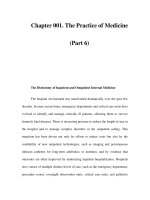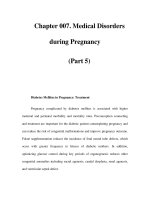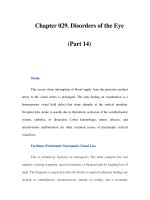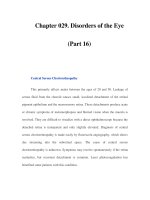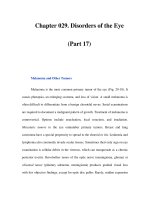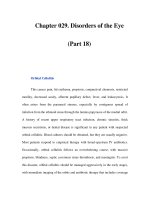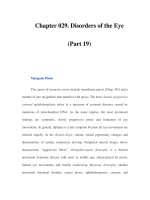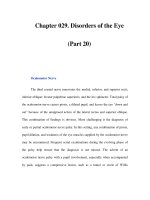Chapter 099. Disorders of Hemoglobin (Part 10) ppsx
Bạn đang xem bản rút gọn của tài liệu. Xem và tải ngay bản đầy đủ của tài liệu tại đây (93.32 KB, 5 trang )
Chapter 099. Disorders of
Hemoglobin
(Part 10)
Low-affinity hemoglobins should be considered in patients with cyanosis or
a low hematocrit with no other reason apparent after thorough evaluation. The P
50
test confirms the diagnosis. Counseling and reassurance are the interventions of
choice.
Methemoglobin should be suspected in patients with hypoxic symptoms
who appear cyanotic but have a Pa
O2
sufficiently high that hemoglobin should be
fully saturated with oxygen. A history of nitrite or other oxidant ingestions may
not always be available; some exposures may be unapparent to the patient, and
others may result from suicide attempts. The characteristic muddy appearance of
freshly drawn blood can be a critical clue. The best diagnostic test is
methemoglobin assay, which is usually available on an emergency basis.
Methemoglobinemia often causes symptoms of cerebral ischemia at levels
>15%; levels >60% are usually lethal. Intravenous injection of 1 mg/kg of
methylene blue is effective emergency therapy. Milder cases and follow-up of
severe cases can be treated orally with methylene blue (60 mg three to four times
each day) or ascorbic acid (300–600 mg/d).
Thalassemia Syndromes: Introduction
The thalassemia syndromes are inherited disorders of α- or β-globin
biosynthesis. The reduced supply of globin diminishes production of hemoglobin
tetramers, causing hypochromia and microcytosis. Unbalanced accumulation of α
and β subunits occurs because the synthesis of the unaffected globins proceeds at a
normal rate. Unbalanced chain accumulation dominates the clinical phenotype.
Clinical severity varies widely, depending on the degree to which the synthesis of
the affected globin is impaired, altered synthesis of other globin chains, and co-
inheritance of other abnormal globin alleles.
Clinical Manifestations of β-Thalassemia Syndromes
Mutations causing thalassemia can affect any step in the pathway of globin
gene expression: transcription, processing of the mRNA precursor, translation, and
posttranslational metabolism of the β-globin polypeptide chain. The most common
forms arise from mutations that derange splicing of the mRNA precursor or
prematurely terminate translation of the mRNA.
Hypochromia and microcytosis characterize all forms of β-thalassemia
because of the reduced amounts of hemoglobin tetramers (Fig. 99-5). In
heterozygotes (β-thalassemia trait), this is the only abnormality seen. Anemia is
minimal. In more severe homozygous states, unbalanced α- and β-globin
accumulation causes accumulation of highly insoluble unpaired α-chains. They
form toxic inclusion bodies that kill developing erythroblasts in the marrow. Few
of the proerythroblasts beginning erythroid maturation survive. The few resulting
RBCs bear a burden of inclusion bodies that are detected in the spleen, shortening
the RBC life span and producing severe hemolytic anemia. The resulting profound
anemia stimulates erythropoietin release and compensatory erythroid hyperplasia,
but the marrow response is sabotaged by ineffective erythropoiesis. Anemia
persists. Erythroid hyperplasia can become exuberant and produce masses of
extramedullary erythropoietic tissue in the liver and spleen.
Figure 99-5
β-Thalassemia intermedia.
Microcytic and hypochromic red blood cells
are seen that resemble the red blood cells of severe iron deficiency anemia. Many
elliptical and teardrop-shaped red blood cells are noted.
Massive bone marrow expansion deranges growth and development.
Children develop characteristic "chipmunk" facies due to maxillary marrow
hyperplasia and frontal bossing. Thinning and pathologic fracture of long bones
and vertebrae may occur due to cortical invasion by erythroid elements and
profound growth retardation. Hemolytic anemia causes hepatosplenomegaly, leg
ulcers, gallstones, and high-output congestive heart failure. The conscription of
caloric resources to support erythropoiesis leads to inanition, susceptibility to
infection, endocrine dysfunction, and in the most severe cases, death during the
first decade of life. Chronic transfusions with RBCs improves oxygen delivery,
suppresses the excessive ineffective erythropoiesis, and prolongs life, but the
inevitable side effects, notably iron overload, usually prove fatal by age 30.
